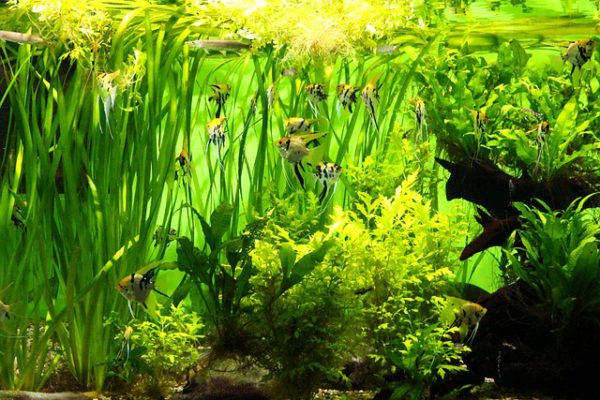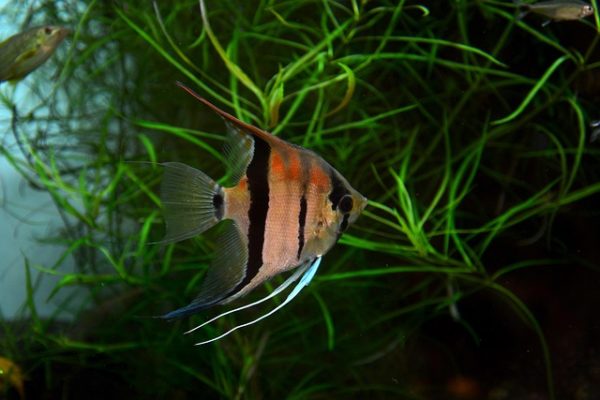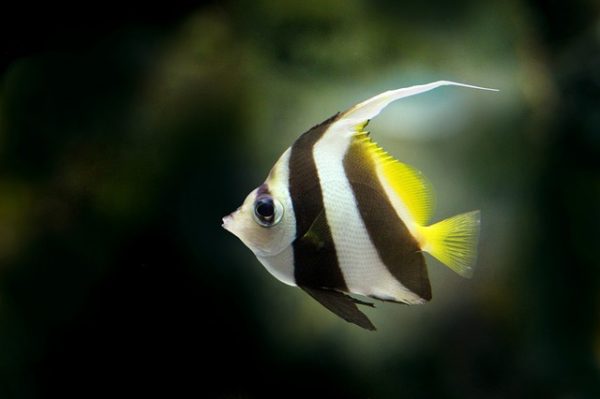Angelfish is a popular freshwater aquarium fish that is from the Cichlidae family. They are native to the Amazon Basin and found in the tropical weathers of South America. While they are very active breeders, they aren’t the most active parents.
This means they won’t pay attention to them once they are done breeding and the fries are born. Breeding angelfish in captivity is quite an easy process, one that shouldn’t take a lot of time to master.
This article will serve as a 101 guide for Angelfish breeding, fertilization, and the way you can take care of an angelfish fry once it is born.
Table of Contents
Angelfish Egg Fertilization Steps

When it comes to breeding your angelfish in captivity, knowing about the basic fertilization steps is vital. Knowing the individual steps will make it easier for you to check if the angelfish eggs are fertilized or not.
Following is a quick breakdown of all the fertilization steps:
Cleaning the Spawning Area
When your male and female angelfish are ready to mate, the first thing they do is start cleaning out the spawning area. This clean-up is a must to ensure their fries are born in a safe and hygienic environment.
The female angelfish cleans the tank area where she will lay the eggs. The whole cleaning process is quite extensive and can range from 18-24 hours. Also, the spawning area might remain the same or change in the future.
Also, if you want to remove the fertilized angelfish eggs once to a separate breeding tank, install a breeding slate or cone to make transfer easier.
Egg-laying
Once the female angelfish is satisfied with cleaning the spawning area, the next step is laying the eggs. Following that, the male angelfish hovers and brushes on the eggs to fertilize them. This leads to the breeding area in the tank filled with the small fertilized eggs of the angelfish. You can either keep them in the tank with the parents or isolate the fertilized eggs.
Look into tank maintenance
As we said, angelfish doesn’t have the most parental attachment to their fries. So, once the breeding happens, they will go about their ways. This is where your role amplifies. Any sudden changes to the tank environments will make the angelfish hostile towards the fertilized eggs.
So, we’d recommend removing these eggs immediately after the fertilization process. However, before the transfer process, make sure you set up a smaller tank with the ideal water parameters.
Also, the tank with the fertilized eggs needs 25% water change every day. You can tend to their needs and monitor their development closely in a separate tank.
Larval pre-hatching stage
This happens around 60 hours after the female angelfish release the eggs. This is where the larvae take shape inside the egg sac. The egg’s color changes too. It goes from translucent to transparent. You can see the larvae and the fry developing inside the yolk sac, which is quite a fascinating experience.
Wiggler stage
This signifies a successful and complete breeding process. The larvae feed on the egg yolk during this stage to contribute to further development.
Fry
Following 3-5 days after the fertilization, the angelfish fertilized eggs turn into free-swimming fry. They gradually grow up to become healthy juveniles. Their feeding and living requirements are different from a healthy adult angelfish.
Caring Tips for Angelfish Eggs

Just knowing about the angelfish fertilization steps isn’t enough. To make the breeding process a success, knowing about the caring tips is just as essential to make the breeding process a success.
If you want to breed an angelfish successfully, there are two things you need to abide by. Set up a separate breeding tank and separate the fertilized eggs from the parents.
However, if you remove the parents from the breeding tank, you need to compensate for many activities. From cleaning the dirt around the eggs to maintaining the water temperature, there’s a lot that needs attention.
Here’s a quick breakdown of the steps to follow:
Acclimatize the eggs
Like adult fish, even the eggs are susceptible to drastic changes. If you transfer the fertilized eggs from their ideal water parameters to a non-ideal one, it will immediately kill them.
In such cases, an egg incubator tank works well. You can store the fertilized eggs in the tank for 24 hours before transferring them out of the breeding tank. Also, when transferring the eggs, keep them in water to prevent drying.
Focus on filtration
In the wild, the parent angelfish clean the breeding area. This involves cleaning the fertilized eggs to get rid of dirt, debris, and algae deposition. To maximize better chances of hatching, the fish tank with the eggs should have an active filter.
Not just the waste, you also need to get rid of the unfertilized and diseased eggs from the tank. For optimal chances of hatching, change 25% of the tank water every day.
Focus on optimal oxygenation
The fertilized eggs need optimal oxygenation in the tank for optimal development. Ideally, we’d recommend installing an air stone with an air pump for the same.
Monitor the water parameters
Like adult angelfish, even the fertilized eggs need optimal water parameters. The water temperature should be between 72-82°F, with a pH between 7-8. Any drastic changes to these parameters will lead to poor health and unsuccessful hatching.
Additionally, when testing the water parameters, check for prominent signs of fungal infection too. You can treat the water with methylene blue to treat infected water and fight off the fungal growth.
How Often Do Angelfish Lay Eggs?
A female angelfish can spawn or lay eggs every two weeks. However, the frequency varies depending on the tank’s age, size, and water parameters.
As easy as the breeding process is, you need to realize that it comes with its set of complications too. Especially for beginners, you might be confused about the next steps in the process. Even though the female angelfish can lay eggs every two weeks, not everyone survives or hatches.
So, as an aquarist, you need to be prepared for the worst. Regardless of the work and labor you put in, some eggs won’t survive, and that’s part of the cycle.
How Many Eggs Do Angelfish Lay at A Time?
A female angelfish can lay between 100-1000 eggs per breeding cycle. This will vary depending on the age, size, and breeding conditions.
How Long Does It Take for Angelfish Eggs to Hatch?
Once the angelfish spawn and lays the eggs, it takes 60 hours to hatch.
The process is extensive and involves the larval phase between spawning and hatching. Following the larval stage, the angelfish fertilized eggs finally hatch into fries.
Maintaining an optimal water temperature of 80 degrees Fahrenheit speeds up the hatching process.
How To Care for Angelfish Fry After They Hatch?
The biggest mistake that aquarists make with angelfish eggs is feeding them prematurely. Feeding the just hatched angelfish fry during the wiggler stage isn’t ideal.
Once the angelfish fry is free-floating and swimming in the tank, that’s when they are ready to be fed.
During the initial stages, the fries will scope the tank for infusoria. Instead, you can feed them brined shrimp and micro worms to supplement their nutritional needs.
The first two weeks should include this essential diet only. Once the fries develop, you can switch to more potent feeds like the flakes and pellets you feed the adult angelfish.
The fries will take between 6 to 8 months to mature completely into their adult self. You can reintroduce the then mature fries into the main tank with other tank mates if you feel comfortable.
What Does It Mean When Angelfish Eggs Turn White?
The primary reason why the angelfish eggs are white is due to a fungal infection. It is highly contagious, so you need to act fast when you see them.
Typically, you are looking for opaque white angelfish eggs in the tank. Once you spot the same, remove the diseased eggs immediately from the breeding tank before the infection spreads. You need to keep a close eye on the other eggs in the later hours and days.
If you can’t seem to get rid of the diseased white eggs from the tank, adding methylene blue is a good alternative. Adding the medicine is like a last resort if the diseased eggs are more than the healthier ones. At this point, you want to save the healthier ones and try to recover the diseased ones too.
What Can Cause Angelfish Eggs to Change Color?
Not just white, the angelfish eggs can change into varying other colors too. It can turn translucent, amber, or even brownish, depending on the cause triggering it.
The most common complications include:
Two females in a breeding tank
With fish, sexual dimorphism is difficult. So, often aquarists mistake two female angelfish as a breeding pair. So, if one female angelfish has laid the eggs, but there are no males to fertilize them, they will die. The laid eggs then turn white and die.
Male infertility
So, you have a male and female angelfish in a breeding tank. The female one has laid the eggs, but an infertile male angelfish won’t fertilize the laid eggs. This also leads to damage and death of the eggs.
Fungal infections
As mentioned earlier, if the eggs contract fungal infections, they will turn white. The disease progresses very quickly, so keep a close eye on the tank during the breeding period.
Issues during transfer
If you keep the angelfish eggs out of the water for too long, it can lead to the death of the eggs too. In such cases, the color of the eggs will change during the process. Poor water conditions or drastic changes in water parameters also contribute to changing the colors of the angelfish eggs.
How To Remove Unfertilized Angelfish Eggs?
One of the most common reasons behind an unsuccessful angelfish breeding cycle is lack of care. Once your eggs are fertilized, you need to check the ones that aren’t.
If the male angelfish have missed out or didn’t fertilize any of the laid eggs, work promptly and remove them. Sometimes, leaving the unfertilized angelfish eggs can become diseased, leading to the death of the fertilized eggs in the tank.
The easiest way to remove unfertilized or diseased angelfish eggs is by using aquascaping tweezers. This is easy to operate and comfortably removes the eggs without damaging them.
How To Prevent Angelfish Eggs from Being Eaten?

Angelfish is quite volatile, especially when protecting their eggs and future fries. However, without the parents, an aquarist has to do a lot of work.
A stable angelfish breeding pair will take all the steps involved in successful breeding. From laying the eggs to cleaning the tank, they will do it all. So, to mimic their functions, you need to follow the same rules.
The best way to prevent the angelfish eggs from being eaten is by including a lot of decorations. You can add aquarium plants, driftwood, and smaller crevices to shield and protect the eggs from predators.
Angelfish Breeding Guide
When you are determined about breeding angelfish, ensure that the process is easy. You have to abide by the water parameters and implement the correct breeding assistance.
Choose a less volatile male and female angelfish instead of the sporadic ones. For successful breeding, the only thing you need to do is create optimal water conditions. That’s all there is to it.
How to set up an Angelfish breeding tank?
Tank Size – the breeding tank should be at least 15-20 inches deep.
Tank Capacity – the tank should be 30-35 gallons minimum.
Breeding equipment – adding a breeding cone/slate supports the cycle.
Decorations – adding plants and gravel into the breeding tank is ideal.
When setting up the breeding tank, some common factors are a must. If you can’t commit to providing these necessities, there’s no point bothering with the breeding process at all.
Tank conditions for breeding Angelfish
Besides the tank setup, a few critical tank conditions and water parameters contribute to a successful breeding cycle.
The water temperature should be between 72-82°F with an optimal 6.8-7.8. Since the fries are very potent to diseases, you need to change 25% of the tank water every day.
Conclusion
Angelfish spruce up the look of an aquarium. So, if you plan to breed your male and female angelfish, these are some of the key pointers to remember. The process is quite simple if you follow the steps religiously.
We hope this article gives you all the insights you need about Angelfish breeding. For more details or further queries, leave us a comment below.



